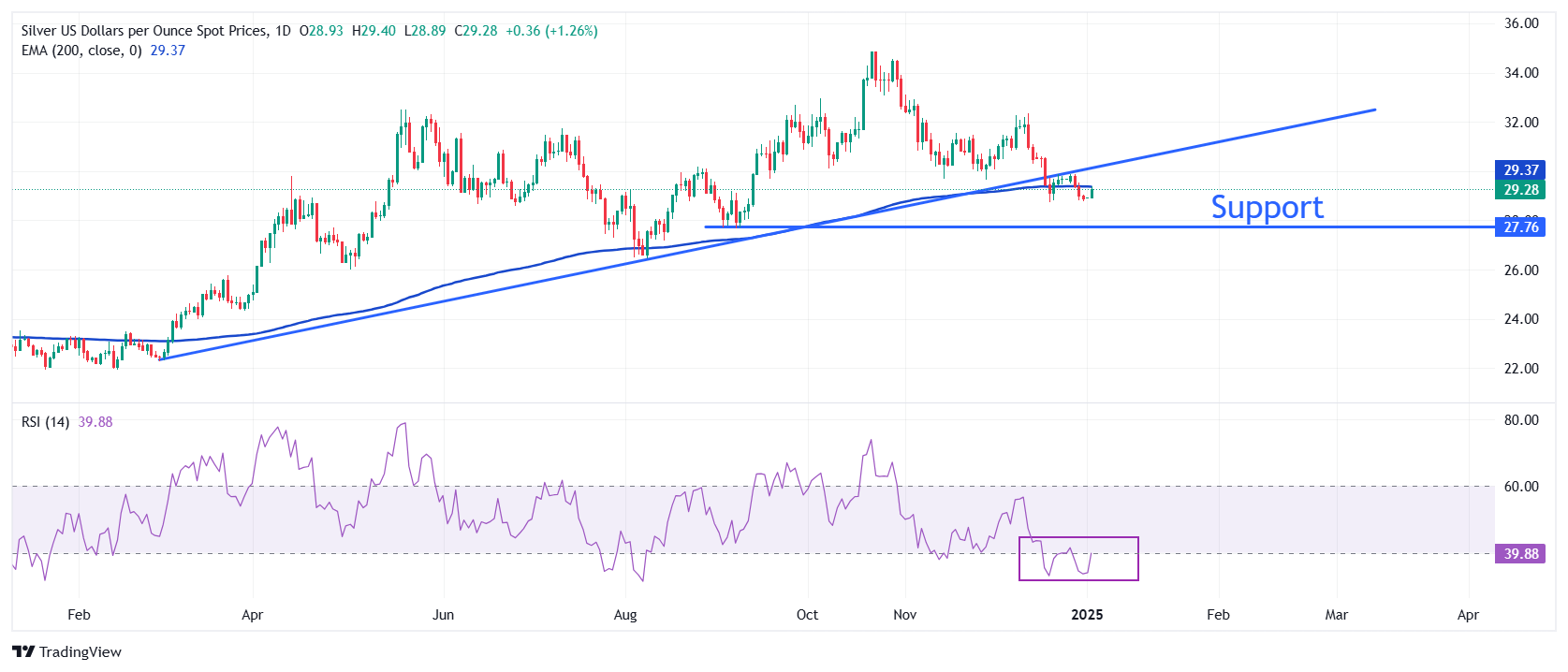Silver Price Forecast: XAG/USD jumps to near $29.40 as rally in US Treasury yields stall
- Silver price climbs to near $29.40 as US bond yields slump, however, their outlook remain firm.
- Trump’s expected policies will likely be pro-growth and inflationary for the US economy.
- Market experts believe that the Fed will deliver its next interest rate cut decision in March.
Silver price (XAG/USD) kicks off 2025 on a strong note. The white metal gains almost 1.50% in Thursday’s European session and climbs to near $29.40. The asset strengthens as the rally in US bond yields has stalled after surging more than 10% in the last four weeks
10-year US Treasury yields slump to near 4.55%. Lower bond yields on interest-bearing assets indicate lower opportunity costs for non-yielding assets, such as Silver, which improves their appeal.
Meanwhile, the US Dollar Index (DXY), which tracks the Greenback’s value against six major currencies, trades sideways near a more-than-two-year high of 108.50.
The outlook of the US Dollar and bond yields is expected to remain firm as the Federal Reserve (Fed) is expected to deliver fewer interest rate cuts this year as officials are upbeat about the economic path. Market participants are also optimistic about the US growth outlook under the administration of President-elect Donald Trump, as his likely policies, such as immigration control, higher import tariffs, and lower taxes, will boost the overall economic activity.
Analysts at Goldman Sachs expect the Fed to deliver the next interest rate cut in March. The investment banking firm also expects that a rate cut of 25 basis points (bps) in March will be followed by two more in June and September, suggesting that borrowing rates will decline in the range of 3.50%-3.75%. In 2024, the Fed also reduced its interest rates three times but by 100 bps to 4.25%-4.50%.
Silver technical analysis
Silver price rebounds sharply to near the 200-day Exponential Moving Average (EMA), which trades around $29.40. However, the outlook of the white metal remains bearish until it stays below the upward-sloping trendline, which is plotted from the February 29 low of $22.30 on a daily timeframe.
The 14-day Relative Strength Index (RSI) rebounds above 40.00. A bearish momentum would come to an end if it sustains above that level.
Looking down, the September low of $27.75 would act as key support for the Silver price. On the upside, the 50-day EMA around $30.90 would be the barrier.
Silver daily chart
Silver FAQs
Silver is a precious metal highly traded among investors. It has been historically used as a store of value and a medium of exchange. Although less popular than Gold, traders may turn to Silver to diversify their investment portfolio, for its intrinsic value or as a potential hedge during high-inflation periods. Investors can buy physical Silver, in coins or in bars, or trade it through vehicles such as Exchange Traded Funds, which track its price on international markets.
Silver prices can move due to a wide range of factors. Geopolitical instability or fears of a deep recession can make Silver price escalate due to its safe-haven status, although to a lesser extent than Gold's. As a yieldless asset, Silver tends to rise with lower interest rates. Its moves also depend on how the US Dollar (USD) behaves as the asset is priced in dollars (XAG/USD). A strong Dollar tends to keep the price of Silver at bay, whereas a weaker Dollar is likely to propel prices up. Other factors such as investment demand, mining supply – Silver is much more abundant than Gold – and recycling rates can also affect prices.
Silver is widely used in industry, particularly in sectors such as electronics or solar energy, as it has one of the highest electric conductivity of all metals – more than Copper and Gold. A surge in demand can increase prices, while a decline tends to lower them. Dynamics in the US, Chinese and Indian economies can also contribute to price swings: for the US and particularly China, their big industrial sectors use Silver in various processes; in India, consumers’ demand for the precious metal for jewellery also plays a key role in setting prices.
Silver prices tend to follow Gold's moves. When Gold prices rise, Silver typically follows suit, as their status as safe-haven assets is similar. The Gold/Silver ratio, which shows the number of ounces of Silver needed to equal the value of one ounce of Gold, may help to determine the relative valuation between both metals. Some investors may consider a high ratio as an indicator that Silver is undervalued, or Gold is overvalued. On the contrary, a low ratio might suggest that Gold is undervalued relative to Silver.

